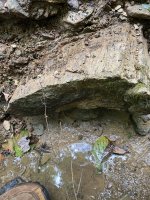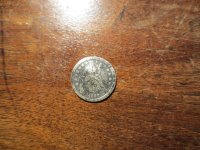petersra
Hero Member
- Apr 26, 2006
- 577
- 14
- Detector(s) used
- Tesoro Tiger Shark + Cheap Radio Shack + Whites DF PI + Aquasound
As a older Newbie with a couple years hunting under my belt, I have greatly benefited from the advise of others on this forum and hope that this thread will give back some of my gained knowledge for those less experienced and be interesting reading for those who are more experienced. Earl passed the central SC coast about 300 miles off shore. I didn't expect it to be a whole lot of action, but decided to go to the beach at high tide about the time Earl was abreast of our coast. From the news reports, various beaches along the local coast had varying amounts of beach erosion based on the wind direction and the orientation of the beach and underwater structure interacting with the wave action, so my information is only for one of many beaches. At the beach I went to, the high tide was much higher on the sand below the dunes than a normal 5.5' high tide would have been. It looked more like a 6.5' tide from the wind driven waves coming up onto the beach. (I understand that at the north end of Folly Island, (not where I was) the erosion was severe, and washed part of the beach parking lot away.) At my beach, the wave action was higher than normal with not a lot of visible erosion, probably 4 - 5' waves (Folly had 8'- 10' waves) when a normal wave height is only 2-3'. The waves were also constant with 4 or 5 waves in some stage of breaking at any time. A normal wave period would be maybe 2 waves in a breaking pattern at any one time..... I hunted the first low tide after the storm passed. The wave and rip tide action was still high and water hunting was not even a consideration. Although the wind had subsided, the surf had not. (About 6 hours after the storm passed.) I hunted the wet sand. I got to the beach several hours before low tide and tested the beach by making successive passes from the dry sand down to the receding water's edge. This method told me where the majority of the targets were collecting, which in this case was the highest 1/3 of the wet sand. As the tide went down to low, I continued testing the wet sand down to low tide which was only a 1.4' tide, so there was a lot of the beach still not exposed. I found very few targets near the low tide line. It appeared that some sand had been pulled off the top part of the beach near the dunes and deposited near the low water mark but there were no visible erosion cuts. I found the first two rings (one appears to be gold with a single small stone to be discussed in another post, and the other is unmarked junk) plus $2.27 in change during that 4 hour hunt. The next day, (18 hours after the storm passed.) I went to another beach to hunt the next low tide which was a 0.5' tide. This lower tide exposed about 30-50' more beach than the previous day with the higher low tide. I again tested the beach from the high water mark down toward low tide and found the targets still concentrated in the upper 1/3 of the wet sand. By this time, the wind was gone but the waves still had not completely subsided. I tried water hunting for 20 minutes at about the time of low tide, but it was still too rough to make it practical. I got no targets in the water and almost no targets below half way between high and low tide. I hunted 6 hours and found $6.27 in change, (including 57 pennies one of which was a 1936 wheatie and 34 dimes). A typical 4-6 hour hunt for me usually yields >$1 but <$3 in clad and maybe a piece of jewelry. There were definitely more targets and a lot of them pennies and dimes, so my thought is that the rough water washed up a lot of lighter coins, but the water was not rough enough to wash any gold out of the depths of the sea, mostly the lighter stuff.... The following day I returned to that same beach because there were additional sections I wanted to hunt and found $2.76 in clad and the third ring with amethyst stone (925 silver). The silver ring was almost at the high water mark and I am convinced it did not wash out of the water onto the wet sand. Today is my first hunt since the holiday and I returned to the first beach. In addition to $2.80 in clad, I found the two pair of sunglasses, junk earrings, fake gold bracelet, and some trinkets of little or no value. All in all it was a great time to experiment with technique, and test both of my detectors. Although the Tiger Shark works well, I seem to find more with the White's Dual Field. However, I know that the Tiger Shark will see smaller gold than the PI. I had fun hunting even if I didn't find a hoard of after-hurricane treasure washed up on the beach. HH to ya, hope this gives some insight to land lubbers wanting to hunt on the coast. Lets see, 18 hours of hunting and I found $13 in clad, one maybe gold ring and one very nice silver ring, which my wife now has on her finger. I count it as some good hunts, but not worth quitting my day job for  Hope your Earl hunts were more productive. Earl stories welcome
Hope your Earl hunts were more productive. Earl stories welcome 
 Hope your Earl hunts were more productive. Earl stories welcome
Hope your Earl hunts were more productive. Earl stories welcome Attachments
Upvote
0


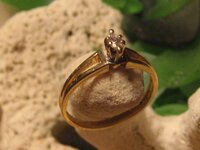
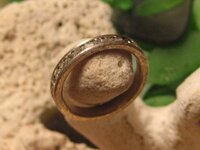
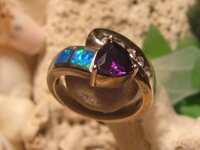
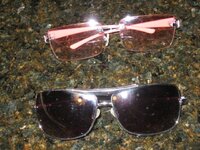
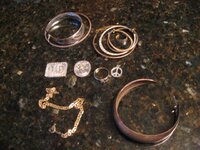
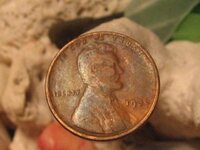
 HH and Good luck. Ralph
HH and Good luck. Ralph

